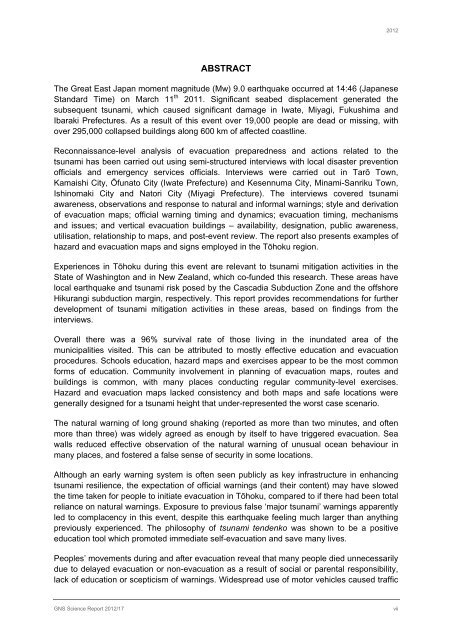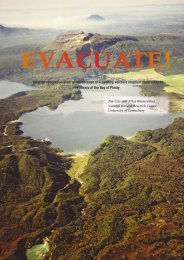Tsunami evacuation: Lessons from the Great East Japan earthquake ...
Tsunami evacuation: Lessons from the Great East Japan earthquake ...
Tsunami evacuation: Lessons from the Great East Japan earthquake ...
You also want an ePaper? Increase the reach of your titles
YUMPU automatically turns print PDFs into web optimized ePapers that Google loves.
2012<br />
ABSTRACT<br />
The <strong>Great</strong> <strong>East</strong> <strong>Japan</strong> moment magnitude (Mw) 9.0 <strong>earthquake</strong> occurred at 14:46 (<strong>Japan</strong>ese<br />
Standard Time) on March 11 th 2011. Significant seabed displacement generated <strong>the</strong><br />
subsequent tsunami, which caused significant damage in Iwate, Miyagi, Fukushima and<br />
Ibaraki Prefectures. As a result of this event over 19,000 people are dead or missing, with<br />
over 295,000 collapsed buildings along 600 km of affected coastline.<br />
Reconnaissance-level analysis of <strong>evacuation</strong> preparedness and actions related to <strong>the</strong><br />
tsunami has been carried out using semi-structured interviews with local disaster prevention<br />
officials and emergency services officials. Interviews were carried out in Tarō Town,<br />
Kamaishi City, Ōfunato City (Iwate Prefecture) and Kesennuma City, Minami-Sanriku Town,<br />
Ishinomaki City and Natori City (Miyagi Prefecture). The interviews covered tsunami<br />
awareness, observations and response to natural and informal warnings; style and derivation<br />
of <strong>evacuation</strong> maps; official warning timing and dynamics; <strong>evacuation</strong> timing, mechanisms<br />
and issues; and vertical <strong>evacuation</strong> buildings – availability, designation, public awareness,<br />
utilisation, relationship to maps, and post-event review. The report also presents examples of<br />
hazard and <strong>evacuation</strong> maps and signs employed in <strong>the</strong> Tōhoku region.<br />
Experiences in Tōhoku during this event are relevant to tsunami mitigation activities in <strong>the</strong><br />
State of Washington and in New Zealand, which co-funded this research. These areas have<br />
local <strong>earthquake</strong> and tsunami risk posed by <strong>the</strong> Cascadia Subduction Zone and <strong>the</strong> offshore<br />
Hikurangi subduction margin, respectively. This report provides recommendations for fur<strong>the</strong>r<br />
development of tsunami mitigation activities in <strong>the</strong>se areas, based on findings <strong>from</strong> <strong>the</strong><br />
interviews.<br />
Overall <strong>the</strong>re was a 96% survival rate of those living in <strong>the</strong> inundated area of <strong>the</strong><br />
municipalities visited. This can be attributed to mostly effective education and <strong>evacuation</strong><br />
procedures. Schools education, hazard maps and exercises appear to be <strong>the</strong> most common<br />
forms of education. Community involvement in planning of <strong>evacuation</strong> maps, routes and<br />
buildings is common, with many places conducting regular community-level exercises.<br />
Hazard and <strong>evacuation</strong> maps lacked consistency and both maps and safe locations were<br />
generally designed for a tsunami height that under-represented <strong>the</strong> worst case scenario.<br />
The natural warning of long ground shaking (reported as more than two minutes, and often<br />
more than three) was widely agreed as enough by itself to have triggered <strong>evacuation</strong>. Sea<br />
walls reduced effective observation of <strong>the</strong> natural warning of unusual ocean behaviour in<br />
many places, and fostered a false sense of security in some locations.<br />
Although an early warning system is often seen publicly as key infrastructure in enhancing<br />
tsunami resilience, <strong>the</strong> expectation of official warnings (and <strong>the</strong>ir content) may have slowed<br />
<strong>the</strong> time taken for people to initiate <strong>evacuation</strong> in Tōhoku, compared to if <strong>the</strong>re had been total<br />
reliance on natural warnings. Exposure to previous false ‘major tsunami’ warnings apparently<br />
led to complacency in this event, despite this <strong>earthquake</strong> feeling much larger than anything<br />
previously experienced. The philosophy of tsunami tendenko was shown to be a positive<br />
education tool which promoted immediate self-<strong>evacuation</strong> and save many lives.<br />
Peoples’ movements during and after <strong>evacuation</strong> reveal that many people died unnecessarily<br />
due to delayed <strong>evacuation</strong> or non-<strong>evacuation</strong> as a result of social or parental responsibility,<br />
lack of education or scepticism of warnings. Widespread use of motor vehicles caused traffic<br />
GNS Science Report 2012/17<br />
vii

















